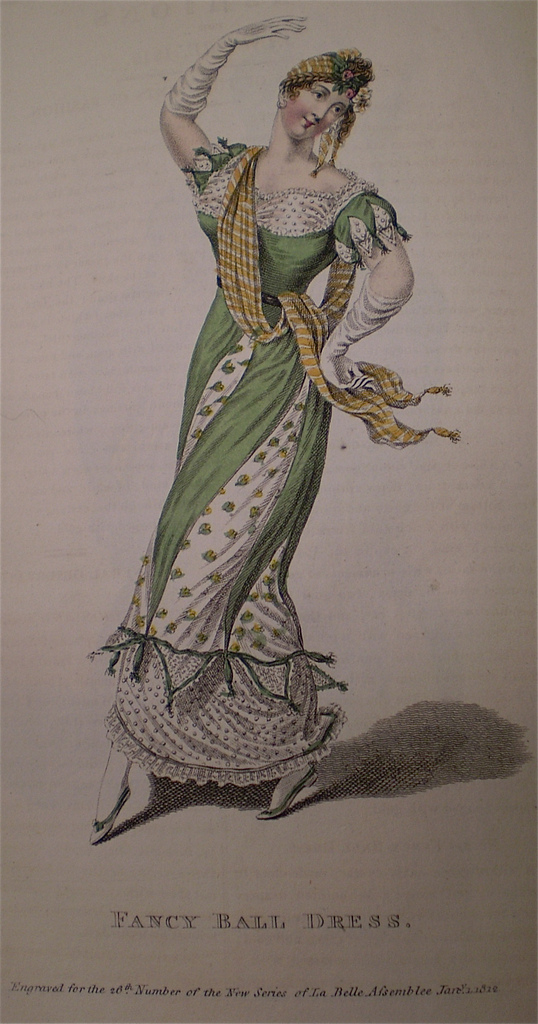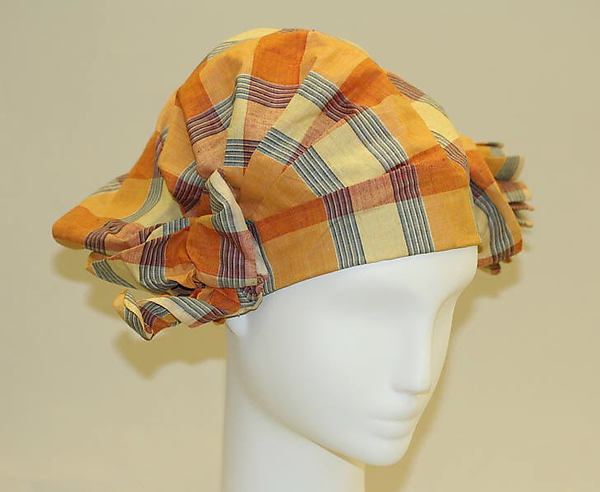So I said I was going to make a tutorial, and so I am.
My Regency turban was made for the Historical Sew Fortnightly Challenge: Yellow.
I had issues with this challenge, because like many I don't really like yellow. But I do like plaid, so when I found a not horrible yellow plaid, I figured a turban would build my wardrobe, not take too long, and be something I could actually wear.
 |
| Not horrible yellow |
 |
| Found on Historical Sewing |
 |
| Ekaterina Karamzina Benner, by Jean Henri Benner |
 |
| American Evening Turban, 1823, cotton. MET |
Nope.
I tried playing around with my fabric to find a way that would work for me, and I couldn't. The plaid was too loud with nothing to offset it. I continued searching, hoping to find something that would allow me to make a yellow plaid turban, when I discovered this:
Yellow jacket and bag, accented with red. A yellow turban might be out, but a red one, with yellow accents? That's more my style.
The turban on the left in the upper picture and top center in the lower picture served as my main inspiration pieces, and I got to work.
I had a half yard of 54 inch wide burgundy linen to serve as the body of the turban cap. At first I played around with a fully fabric cap,
but realized I was going to need some kind of structure. Dollar Store fedora to the rescue!
I cut off the brim and covered the edge and base with a three inch wide strip of linen. The linen was sewn to the inside, even with the edge, folded over to the outside, and tacked down with running stitches. I also cut off the top to make more room for my dreads. That edge was covered with ribbon, folded over the edge and hand sewn.
 |
| Dread space |
 |
| Don't look at the camera. Look anywhere but the camera. |
Next came the plaid bit. I had some cotton quilt batting on hand, so I rolled up a log of it about 2 inches in diameter and long enough to fit around the cap.
 |
| Loosely rolled batting |
A bias strip of plaid wide enough to go around the log (plus seam allowances) and long enough to cover it with overhang was cut, folded in half lengthwise, and stitched.
 |
| Looking closely you can see little hand stitches along the top edge. |
 |
| Turning |
and inserted into the plaid tube
 |
| Ta-da! |
The trim was pulled tight to cause the plaid tube to puff out in-between, but to avoid looking overly structured it was only stitched together where it met the seam. If you look closely you can see the ends of the white thread where the trim is attached at the seam.
Then some burgundy tassel trim was added where the crown met the brim
and was then completely hidden by the plaid.
 |
| I wanted it to peek out like this, but I didn't secure the roll far enough back so the tassel trim became completely hidden. Oh well. |
 |
| Trying to let the tassel trim show |
 |
| My needle literally snapped between my fingers as I was trying to maneuver it. |
stitching them together into one long tube (so I didn't have to worry about hiding the raw edges), and began playing around.
I finally decided on folding the linen tube in half and braiding it with the two cords. That was tacked on repeatedly until I was happy with the style.

Sorry the pictures are all over, I'm not good at this.
The braid had its center point tacked over the plaid roll, with each end wrapping under the fabric at the back of the head and the ends over each other just behind the plaid roll. This was stitched down here and there, wherever I thought it was necessary (generally wherever I had pinned it during the trying on stage).
 |
| Sewing in progress |
 | |
| And stitches nicely hidden. The braid is only stitched to the fabric, not to the structure underneath, to keep it relaxed looking. |
 |
| The ends of the braid, stitched down on top of one another. |
was simply folded over and stitched at the tip.
 |
| Please ignore the box of Cheez-its and the raccoon piggy back in the background. |
After this more trim was acquired, this time an inch wide yellow upholstery trim. This stitched onto the brim.
And around the point in the back, hiding the cut edges under folds of fabric to make it look continuous.
Next was tassels. The ones I bought were attached to a cord, so first they were freed.
The ends were knotted, the tips of the plaid roll were folded around it, and it was stitched together.

Blurry stitching photo, but you get the idea. The knot gives a nice secure point to stitch around, so I don't have to worry about the cord unravelling.
Brown piping was added around the brim edge, stitched carefully to prevent the thread from showing on the right side.
 |
| Flawless |
 |
| The strands sink into the cap, to give the appearance of wrapping. |
 |
| I think maybe the moon should be pointing the other direction, but I'm too lazy to change it. |
And I can shove the dreads in, though the cap looks a little weird when I do.
Though not weirder than period caps, so I think it works. The only extra not pictured is the strip of muslin hemmed and stitched to the inside to hide stitches and the bits.
I didn't really use a pattern for this cap, and I'm not certain of the period accuracy, but it hides my anachronistic hair and I'm happy with it.
For other tutorials that I used to help me (and that you may want to refer to if I was unclear) Festive Attyre did an excellent post on making hers, and Lynn McMasters has a guide to making the padded roll on the turban.
So there you go, a brick of text and photos. Hope it's helpful!

































No comments:
Post a Comment